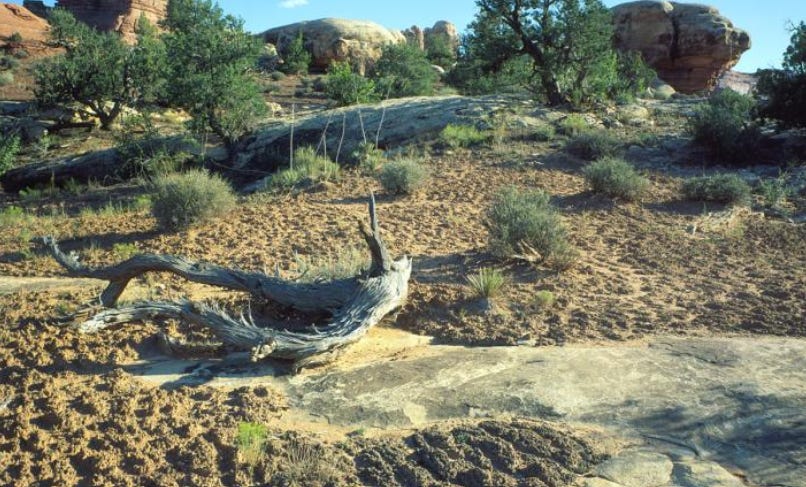Welcome to The Four Corners of the Southwest. My love for travel and the outdoors has inspired me to learn, research, and share interesting information about the American Southwest.
Be careful where you walk! In some places in the Four Corners area, the soil is alive!!
What are Biological Soil Crusts?
Biological soil crusts are communities of living organisms on the surface of the soil in arid and semi-arid ecosystems. Even though they are found around the world from the Colorado Plateau’s high desert to the arctic, the look of the soil crusts varies geographically.
Some of the most interesting are found in southeastern Utah. The pictures provided in this post are from that area including Canyonlands National Park, Capitol Reef National Park, Arches National Park, Natural Bridge National Monument, and Hovenweep National Monument.
In southeastern Utah, the biological soil crust is mainly knobby and black looking. It is an entire community of microscopic organisms including:
Algae
Fungi
Lichen
Mosses
Cyanobacteria
What is Cyanobacteria?
Cyanobacteria, previously called blue-green algae, are some of the oldest known life forms. When they get wet, they move through the soil leaving behind long, sticky fibers. These fibers join soil particles together, creating a thick layer of soil. Together, these organisms create a continuous living crust.
Cyanobacteria is also a “nitrogen fixer” which means it converts atmospheric nitrogen into a form that plants can use. This is very important in desert ecosystems as nitrogen is generally low.
Erosion Control
Biological soil crusts are resistant to erosion by both wind and water because the soil particles stick together. This helps keep the sandy soil from washing away in the rain or blowing away in the wind. In addition, mosses and lichens have rootlike anchoring structures that penetrate into the soil and provide further stability.
Water Retention
After a rain, soil crust soaks up water like a sponge, absorbing and storing it. This is especially important in arid areas that experience sporadic, heavy rainfall. The organisms in the crust can absorb up to ten times their volume of water and release the water slowing into the soil once the rain ends.
National Park Service (NPS) site explaining biological soils
Canyonlands National Park video about biological soils
Human Impacts
Unfortunately, humans can destroy soil crust and often do so without meaning to. Vehicle tracks, bicycles, and footprints are extremely harmful – even a single footprint can kill the soil crust immediately below. Continuous pressure can break up the crust. Then, rain or wind can scatter the pieces.
Impacted areas may never fully recover. Under the best circumstances, a thin veneer of biological soil may return in five to seven years. Mature crusts can take 50 years to strengthen. Lichens and mosses may take hundreds of years to recover.
There are ways to avoid “Busting the Crust”. Please observe the following rules:
Stay on existing trails.
When you must go off trail, walk in wash bottoms or on slickrock where soil crusts don’t develop.
Camp in established sites, on slickrock or in previously disturbed areas.
Go out of your way, literally, to avoid biological soil crust.
If you’ve found this post interesting, please share with others!
Next Time
I’m sure you’ve seen the “Tourons of Yellowstone” on Instagram. If you haven’t, check it out. Mainly it features videos of “TOURist morONS” trying to pet or ride a buffalo or something similar. While I’m sure all of us here love and care for the outdoors but sometimes we don’t realize an impact we might have on wildlife or the environment. I will go over some helpful information to keep us from being a Touron.










Very informative! I had no idea about so much of this! Don’t be a Touron, stay on the path!